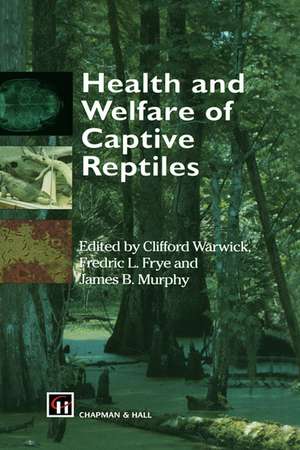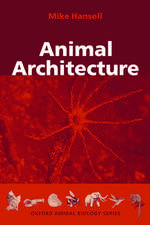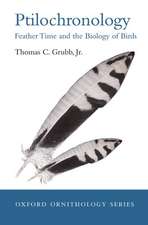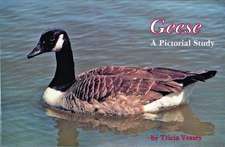Health and Welfare of Captive Reptiles
Editat de Clifford Warwick, F.L. Frye, J.B. Murphyen Limba Engleză Hardback – 30 noi 1994
Preț: 1550.92 lei
Preț vechi: 1891.38 lei
-18% Nou
Puncte Express: 2326
Preț estimativ în valută:
296.76€ • 310.68$ • 245.56£
296.76€ • 310.68$ • 245.56£
Carte tipărită la comandă
Livrare economică 07-21 aprilie
Preluare comenzi: 021 569.72.76
Specificații
ISBN-13: 9780412550805
ISBN-10: 0412550806
Pagini: 299
Ilustrații: XIII, 299 p.
Dimensiuni: 155 x 235 x 19 mm
Greutate: 0.63 kg
Ediția:1994
Editura: SPRINGER NETHERLANDS
Colecția Springer
Locul publicării:Dordrecht, Netherlands
ISBN-10: 0412550806
Pagini: 299
Ilustrații: XIII, 299 p.
Dimensiuni: 155 x 235 x 19 mm
Greutate: 0.63 kg
Ediția:1994
Editura: SPRINGER NETHERLANDS
Colecția Springer
Locul publicării:Dordrecht, Netherlands
Public țintă
ResearchCuprins
Introduction: Health and welfare of captive reptiles.- 1 Physiology and functional anatomy.- 1.1 Introduction.- 1.2 Body temperature, energetics and ectothermy.- 1.3 Light and photoreception.- 1.4 Water exchange and humidity.- 1.5 Digestive physiology and nutrition.- 1.6 Respiration and circulation.- 1.7 Pain and stress.- 1.8 Conclusion.- Acknowledgements.- References.- 2 Biology of stress: interactions with reproduction, immunology and intermediary metabolism.- 2.1 Introduction.- 2.2 Reproduction.- 2.3 Immunity.- 2.4 Corticosteroids, intermediary metabolism and growth.- 2.5 Implications for captive husbandry of reptiles and future research.- Acknowledgements.- References.- 3 Nutritional considerations.- 3.1 Introduction.- 3.2 Provision of an adequate water supply.- 3.3 Selection of food.- 3.4 Apprehension of prey and gathering of fodder.- 3.5 Initial processing.- 3.6 Assimilation.- 3.7 Elimination.- 3.8 Miscellaneous factors and their effects on nutrition.- 3.9 Concluding remarks.- References and further reading.- 4 Veterinary perspectives and techniques in husbandry and research.- 4.1 Introduction.- 4.2 Captive reptiles.- 4.3 Free-living reptiles.- 4.4 Conclusions.- Acknowledgements.- References and recommended reading.- 5 Naturalistic versus clinical environments in husbandry and research.- 5.1 Introduction.- 5.2 Context: Welfare in husbandry and research.- 5.3 Terminology for wild and captive reptile environments.- 5.4 Naturalistic versus clinical environments.- 5.5 Conclusions.- 5.6 Recommendations.- Acknowledgements.- References.- 6 Normal behaviour.- 6.1 Introduction.- 6.2 Maintenance behaviours.- 6.3 Distance-reducing behaviour.- 6.4 Agonistic behaviour.- 6.5 Conclusions.- References.- 7 Effects of ontogenetic processes and rearing conditions.- 7.1 Introduction.- 7.2 The prenatal period.- 7.3 Parental care.- 7.4 Handling and novel environments.- 7.5 Cage size and structure.- 7.6 Social arrangements.- 7.7 Feeding.- 7.8 Defensive behaviour.- 7.9 Long-term influence of captive regimes.- 7.10 Conclusions.- Acknowledgements.- References.- 8 Behavioural consequences of husbandry manipulations: indicators of arousal, quiescence and environmental awareness.- 8.1 Introduction.- 8.2 Cage cleaning and exploratory behaviour.- 8.3 Use of familiar artificial chemical cues.- 8.4 Chemical recognition of self.- 8.5 Sensitivity to spatial considerations.- 8.6 General discussion.- Acknowledgements.- References.- 9 Psychological and behavioural principles and problems.- 9.1 Introduction.- 9.2 Living wild and noticing captivity.- 9.3 Recognizing and interpreting signs of psychological and ethological well-being and poor welfare.- 9.4 Specific psychological and ethological problems.- 9.5 General considerations.- 9.6 Conclusions.- Acknowledgements.- References.- 10 Ethologically informed design in husbandry and research.- 10.1 Introduction.- 10.2 Ethologically informed design.- 10.3 Case studies: ethologically integrated designs.- 10.4 Recommendations and conclusions.- Acknowledgements.- References.- 11 Miscellaneous factors affecting health and welfare.- 11.1 Introduction.- 11.2 Stress, pain and sensitivity.- 11.3 Thermal factors, thermoregulation and light.- 11.4 Growth.- 11.5 Electromagnetism in the artificial environment.- 11.6 Reintroductions to nature.- 11.7 Euthanasia and killing.- 11.8 Conclusions.- Acknowledgements.- References.
Recenzii
`The narratives are well written and sufficiently user-friendly to be read by almost anyone who raises reptiles. The book will be particularly useful for vertebrate zoologists, veterinarians, reptile breeders, and zoo keepers.'
Choice
`This book is a welcome addition to the steadily increasing library of herpetological literature ... an impressive international group of contributors are to be found within.'
The Veterinary Record
`The editors are acknowledged experts in this field, and a great deal of care has gone into the production of this book, involving 17 contributors in addition to the editors.'
CAB International, Veterinary Bulletin
`This book is an interesting early examination of the animal welfare aspects of working with reptiles in captivity and also in nature.'
The Herpetological Journal
`To review such a packed volume is difficult indeed, in order to give the correct credence to its excellence ... a most important step forward in the cataloguing of existing knowledge on the subject ... essential reading for all workers in the field ...'
UWAF
Choice
`This book is a welcome addition to the steadily increasing library of herpetological literature ... an impressive international group of contributors are to be found within.'
The Veterinary Record
`The editors are acknowledged experts in this field, and a great deal of care has gone into the production of this book, involving 17 contributors in addition to the editors.'
CAB International, Veterinary Bulletin
`This book is an interesting early examination of the animal welfare aspects of working with reptiles in captivity and also in nature.'
The Herpetological Journal
`To review such a packed volume is difficult indeed, in order to give the correct credence to its excellence ... a most important step forward in the cataloguing of existing knowledge on the subject ... essential reading for all workers in the field ...'
UWAF















